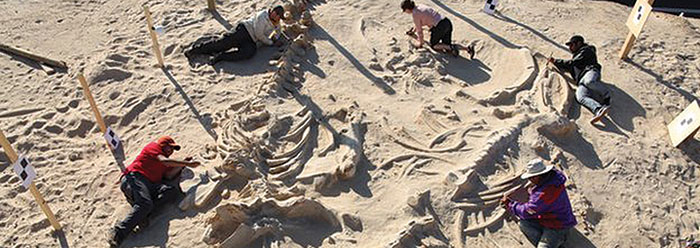According to a recent evolutionary article, anywhere from 6.5 to 9 million years ago a catastrophic event occurred in what is now the Atacama region of Chile.1 Four distinct layers of fossil marine mammals were unearthed on the edge of one of the driest deserts on the planet, leading evolutionists to exclaim, “There has never been a find of this size or this diversity anywhere in the world.”2 Indeed, at least 40 baleen (water-filtering) whales—species including minke, fin, and the modern blue whales—were found, as well as seals, dolphins, and sharks.
The Proceedings of the Royal Society B study on this amazing discovery begins with a paean to evolutionism, claiming that marine mammals “evolved from trophic obscurity.”1 In other words, land mammals—doing just fine where they were—decided to venture back into water, where they made incredible physiological and anatomical adjustments to their new aquatic life. One secular paleontologist asserts that although hard to imagine, this transition did in fact happen:
Looking at the great blue whale, 30 m [~100 feet] long, or a fast-swimming dolphin, it is hard to imagine how they evolved from terrestrial mammal ancestors, and yet that is what happened.3
With no compelling fossil evidence for these remarkable alterations, we begin our commentary on this Chilean discovery by recognizing that the creatures are 100 percent modern whales, seals, dolphins, and sharks. The fossils are “remarkably complete, having being subjected to very little scavenging at death” despite having “a few nicks,” possibly made by crabs, according to a BBC article.4
What phenomenon would bury an unbelievably dense accumulation of complete and articulated whales, belly up, along a line parallel to the coast? What could have done this to such capable swimmers? Secular scientists suggested four separate mass strandings, but a better explanation might involve successive, inescapably strong tsunamis or currents.
While the evidence clearly suggests some kind of flood of catastrophic proportions, the study’s explanation veers to an altogether bizarre conclusion: The creatures all died due to a supposed algal bloom and were then washed ashore by storm waves. Although proffered as a very plausible explanation, the evidence for such mass poisoning is tenuous at best. For instance, area sediments were free of algal cell fragments, and why would an algal bloom suddenly kill all these various species? There were small spheres in the sediments the correct size to be dinoflagellate (marine algae) cysts, but were they of the deadly type? Scientists simply do not know. Regardless, secular explanations must avoid the obvious in this case and create other explanations unfettered from cataclysmic (biblical) explanations.
Evolutionary geologists state these four layers, or horizons, of the fossil vertebrates span some 16,000 years. But in virtually every circumstance time is actually the enemy of evolution. The supposed age of the deposit is 3.5 million years, meaning these deposits formed during one half of one percent of that time. Are we expected to believe that things were placid and calm for the rest (99.5 percent) of the time as measured in millions of years? No other storm surges or killer tides interrupted the peaceful and tranquil uniformitarian time? If these layers really did span 16,000 years then there should be dozens of other similar graveyards.
Creation scientists have a more credible explanation not based on ethereal millions of years or cryptic poisonous algal blooms. Masses of well-preserved fossils of various modern types—their bodies remarkably unscavenged and whole—indicate an enormous widespread catastrophic process, considerably more than a mere storm surge.
References
- Pyenson, N. et al. 2014. Repeated mass strandings of Miocene marine mammals from Atacama Region of Chile point to sudden death at sea. Proceedings of the Royal Society B. 281 (1781): 20133316.
- Halliday, J. Whale graveyard shows mass stranding of species millions of years ago. The Guardian. Posted February 26, 2014, accessed March 2, 2014.
- Benton, M. J. 2015. Vertebrate Palaeontology. Hoboken, NJ: Wiley-Blackwell Publishing, 372.
- Amos, J. Chile’s stunning fossil whale graveyard explained. BBC News. Posted on bbb.com February 25, 2014, accessed March 2, 2014.
Image credit: Copyright © 2014 Adam Metallo, Smithsonian Institution. Adapted for use in accordance with federal copyright (fair use doctrine) law. Usage by ICR does not imply endorsement of copyright holders.
* Mr. Sherwin is Research Associate, Senior Lecturer, and Science Writer at the Institute for Creation Research.






















